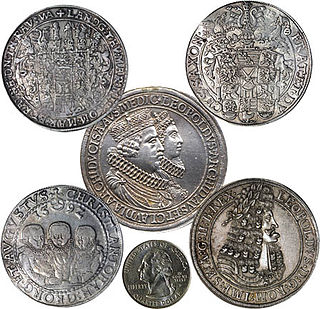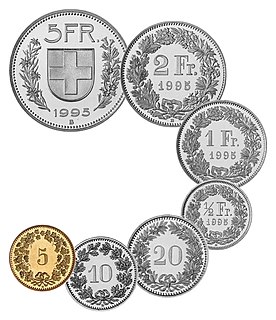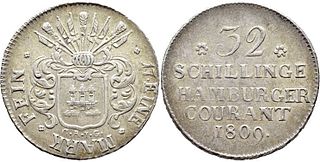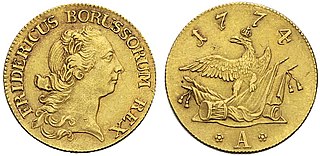Related Research Articles

A thaler is one of the large silver coins minted in the states and territories of the Holy Roman Empire and the Habsburg monarchy during the Early Modern period. A thaler size silver coin has a diameter of about 40 mm (1½") and a weight of about 25 to 30 grams, or roughly 1 ounce. The word is shortened from Joachimsthaler, the original thaler coin minted in Joachimstal, Bohemia, from 1518.

The Scandinavian Monetary Union was a monetary union formed by Denmark and the Swedish part of the Union between Sweden and Norway on 5 May 1843, by fixing their currencies against gold at par to each other. After the dissolution of the Swedish-Norwegian union, in 1905, Norway continued to be a part of this monetary union. The union ended with the outbreak of World War I.

The mark was a currency or unit of account in many nations. It is named for the mark unit of weight. The word mark comes from a merging of three Teutonic/Germanic words, Latinised in 9th-century post-classical Latin as marca, marcha, marha or marcus. It was a measure of weight mainly for gold and silver, commonly used throughout Western Europe and often equivalent to eight ounces. Considerable variations, however, occurred throughout the Middle Ages.

The Swiss franc is the currency and legal tender of Switzerland and Liechtenstein. It is also legal tender in the Italian exclave of Campione d'Italia. The Swiss National Bank (SNB) issues banknotes and the federal mint Swissmint issues coins.
The livre tournois, French for the "Tours pound", was one of numerous currencies used in France in the Middle Ages, and a unit of account used in Early Modern France.

The Maria Theresa thaler (MTT) is a silver bullion coin and a type of Conventionsthaler that has been used in world trade continuously since it was first minted in 1741. It is named after Empress Maria Theresa, who ruled Austria, Hungary, and Bohemia from 1740 to 1780 and is depicted on the coin.
Groschen was the name for a silver coin used in various states of the Holy Roman Empire.

Goldmark was the gold standard-based currency of the German Empire from 1873 to 1914. Papiermark was the much-devaluated Mark after the gold standard was given up in August 1914, and gold and silver coins ceased to circulate.

Pistole is the French name given to a Spanish gold coin in use from 1537; it was a double escudo, the gold unit. The name was also given to the Louis d'Or of Louis XIII of France, and to other European gold coins of about the value of the Spanish coin. One pistole was worth approximately ten livres or three écus, but higher figures are also seen. The derivation is uncertain; the term may come from the Czech píšťala, or from the Italian town of Pistoia; either way, it was originally spelled pistolet and originated in military slang, and probably has the same root as pistol.

The Vereinsthaler was a standard silver coin used in most German states and the Austrian Empire in the years before German unification.
The Conventionsthaler was a standard silver coin of the Holy Roman Empire. It was introduced in 1754 and contained one tenth of a Cologne mark of silver or about 23.39 grams. Its most famous example is the Maria Theresa thaler which is still minted today.

The Reichsthaler was a standard Thaler silver coin of the Holy Roman Empire, established in 1566 by the Leipzig convention. This original Reichsthaler specie was supplemented in the 16th century by various Reichsthaler units of account in northern Germany in the 17th century and by a Prussian Reichsthaler coin in 1750.
The Cologne Mark was a unit of weight equivalent to 233.856 grams. The Cologne mark was in use from the 11th century onward. It came to be used as the base unit for a number of currency standards, including the Lübeck monetary system, which was important in northern Europe in the late Middle Ages, and the coinage systems of the Holy Roman Empire, most significantly the conventionsthaler, which was defined as one tenth of a Cologne Mark and replaced the reichsthaler which had been 1⁄9 of a Cologne mark.
The guilder or fl. was the currency of the Netherlands from the 17th century until 2002, when it was replaced by the euro. Between 1999 and 2002, the guilder was officially a "national subunit" of the euro. However, physical payments could only be made in guilders, as no euro coins or banknotes were available. The Netherlands Antillean guilder is still in use in Curaçao and Sint Maarten, but this currency is distinct from the Dutch guilder. In 2004, the Surinamese guilder was replaced by the Surinamese dollar.

The Gulden or forint was the currency of the lands of the House of Habsburg between 1754 and 1892, when it was replaced by the krone/korona as part of the introduction of the gold standard. In Austria, the Gulden was initially divided into 60 Kreuzer, and in Hungary, the forint was divided into 60 krajczár. The currency was decimalized in 1857, using the same names for the unit and subunit.
The Gulden was the currency of the states of southern Germany between 1754 and 1873. These states included Bavaria, Baden, Württemberg, Frankfurt and Hohenzollern. It was divided into 60 kreuzer, with each kreuzer worth 4 pfennig or 8 heller.

The Hamburg Mark refers to two distinct currencies issued in the city of Hamburg and used throughout the rest of Germany until 1875:

The Kronenthaler was a silver coin first issued in 1755 in the Austrian Netherlands and which became a popular trade coin in early 19th century Europe. Most examples show the bust of the Austrian ruler on the obverse and three or four crowns on the reverse, hence the name which means "crown thaler" (also Brabanter and crocione.
The Thaler was the currency of Prussia until 1857. From 1750, it was distinct from north German Reichsthaler unit of account in that it contained 1⁄14 of a Cologne mark of silver, rather than 1⁄12, and was minted as a coin. This change was implemented by Johann Philipp Graumann and the system of 14 thaler to the mark was known as the Graumannscher Fuß.

The Friedrich d'or was a Prussian gold coin (pistole) nominally worth 5 silver Prussian Reichsthalers. It was used from 1741 to 1855 and since it was a silver standard regular issue coin and trade coin at this time, it had a different purpose to domestic silver coinage or Kurantgeld, the so-called window on the stock exchanges. It was normally traded at a small premium or discount to the face value of 5 thalers. In Prussian purchase contracts or bonds it was, due to its monetary usage, distinguished as the "preußisch Courant" or "Friedrich d'or".